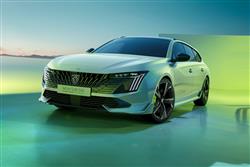Peugeot 508 SW - ABC Leasing
How will you view?
This is a sample, showing 30 seconds of each section.
AFTER EIGHT(some text hidden)
By Jonathan Crouch
Ten Second Review word count: 56
A significant number of Peugeot 508 customers choose the SW estate version - and you can see why. It's sensibly practical, yet very good looking. And of course it also benefits from all the technology that's revitalised the improved version of the four-door second generation 508 model's proposition in the ever more competitive medium range market.
Background word count: 170
The humble station wagon. No longer quite so humble these days. In fact, estates have become something of a fashion statement in recent years. You'd choose one over the ordinary saloon model even if you didn't necessarily need the extra carrying space. Most Peugeot 508 buyers do. Here's the 508 SW model, back in 2023 rejuvenated to take on a raft of tough rivals including estate versions of models like the Skoda Superb and the Volkswagen Passat. So today, what does a potential 508 SW buyer now really want? Experience in the market suggests three things: style, class and technology. In response, Peugeot has put a lot more thought into this car, now offered only in Hybrid 225 PHEV form. It looks more up-market - and we're promised that it will feel that way when you take a seat behind the wheel. There's extra hi-tech equipment too, with things you'd have to pay extra for on some rivals. So, has the French brand got this recipe right? Let's find out.
Driving Experience word count: 231
As you'd expect, this SW variant drives just as its Fastback stablemate does. The PHEV tech adds a portly 280kgs to the kerb weight of this 508. The first generation 508 SW design was available in electrified form too, but that was a self-charging set-up mated to a diesel engine. In this 'R83'-series model, a 181hp 1.6-litre turbo petrol powerplant combined with an 8-speed auto gearbox is mated to a 110hp electric motor on the front axle powered by a 12.4kWh lithium-ion battery. When fully charged, this allows for up to 42.3 miles of WLTP-rated all-electric driving range. There's a 225hp system output. You get four driving modes, with the ones you'll be using most of the time being the 'Hybrid' and 'Comfort' settings that choose the best mix of electric and petrol propulsion to suit the driving style whilst optimising efficiency, the latter softening the standard adaptive damping. The alternative settings are either 'Sport' (where the car combines the power of the electric and petrol motors to offer livelier performance). And 'Electric' (battery power only), in which guise the car is apparently able to run at up to 84mph. With the engine chiming in, 62mph from rest occupies 8.0s and top speed is limited to 149mph. The hybrid system's extra weight slightly blunts the handling but refinement is exemplary (even with the PureTech engine working) and the ride is superb.
Pictures (High res disabled)

.jpg)
.jpg)
.jpg)
.jpg)
white.jpg)
white.jpg)
white.jpg)

Scoring
Category: Compact Car
| Performance | |
| Handling | |
| Comfort | |
| Space | |
| Styling | |
| Build | |
| Value | |
| Equipment | |
| Economy | 80% |
| Depreciation | 70% |
| Insurance | 70% |
| Total | 74% |